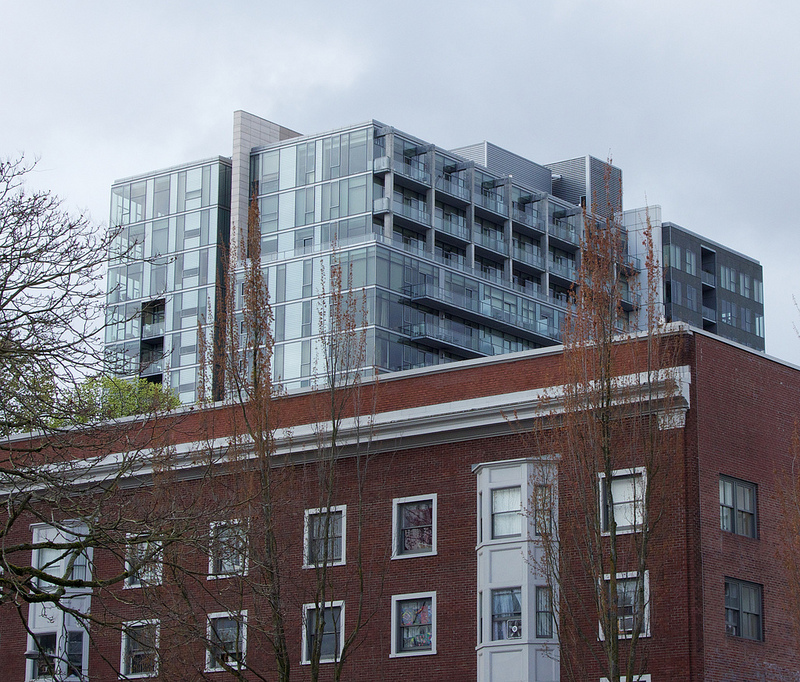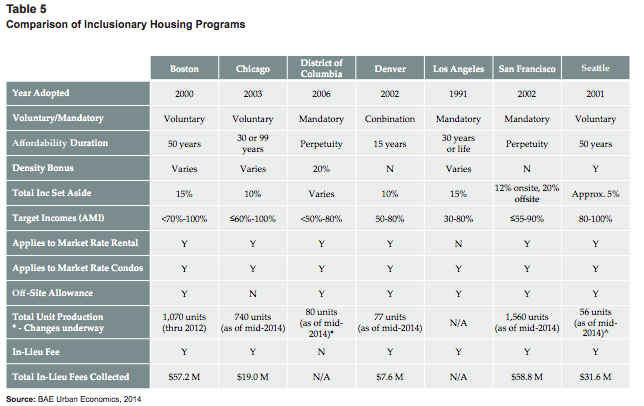Why Portland’s proposed inclusionary zoning plan will likely make housing less affordable
As we reported in September, Portland Oregon is moving ahead with plans to enact an inclusionary housing requirement. Briefly, the proposal would require all newly constructed apartment buildings with 20 or more units to set aside 20 percent of units for housing affordable to families earning less than 80 percent of the city’s median income, currently about $58,000 per year.
Portland’s housing affordability problem is serious and real. And it’s deeply rooted in policies that have been in effect for years or decades. Like many cities, Portland has been overwhelmed by the growing demand for urban living, and the supply of new rental housing has been growing only slowly.

Advocates believe that enacting an inclusionary zoning requirement will, overnight, make this problem better. But as proposed, Portland’s inclusionary zoning program is likely not only to not solve the problem at hand, but could well make the city’s housing affordability problems demonstrably worse. Though well-intended, this is probably a fundamentally counterproductive action.
Size Matters
Inclusionary zoning advocates have told the Portland City Council that inclusionary requirements are commonplace, that hundreds of jurisdictions have such policies, and that despite the concerns of economists, there’s little evidence that they’ve actually led to declines in development.
This talking point elides the critical question of size. Nearly all of the jurisdictions that have inclusionary zoning programs are suburbs or small towns. Virtually all of them produce a handful, or at most dozens of affordable units per year. Of the major urban centers with inclusionary zoning, only three or four have produced more than 100 units per year, according to detailed compiled for New York City’s planning department:
This data helps put the claims that have been made that inclusionary zoning has no discernible negative effects on housing markets in context: The reason why the negative effects of inclusionary zoning have been hard to detect is that the scale of these programs in practice is so small.
If you look in detail and these programs, you can see why they are so small. Mostly, its because the jurisdictions that have imposed them are very small. In larger cities (Boston, Chicago, New York), the inclusionary zoning requirements only apply in some neighborhoods, to some kinds of development, and in some situations (for example, where there is a public subsidy or where there’s a major re-zoning).
Details Matter
Much has been made that some of these programs have been “voluntary” and that as they shift “mandatory” they will somehow become more effective. Most prominently, New York City has had a voluntary inclusionary zoning program for more than a decade. Earlier this year, with great fanfare, the New York City Council approved Mayor de Blasio’s proposal to enact a mandatory inclusionary zoning program. That certainly sounds impressive. But the reality is actually quite different.
In reality, the new NYC inclusionary housing program only applies when developers seek to up-zone property from its current allowable levels of density. The NYC plan does not apply to by-right development of existing properties. Moreover, the City Council has to approve—case-by-case—the density increases associated with the inclusionary housing. So far, two developers have come forward with proposals to build larger buildings that used density bonuses and up-zoning to accommodate affordable units. In both cases, the City Council, in response to local opposition and aldermanic privilege, denied the up-zones.
Offsets Matter
The policy attractiveness of inclusionary zoning requirements is that they seem like something for nothing: The perception is that the city can somehow make greedy developers forego some of their excessive profits and pay for affordable housing at little or no cost to the public. As in so many other areas, here there is no free lunch. Affordable units will cost more to build than they generate in rent, and developers will have to make back this cost by charging higher rents to other tenants or getting cost reductions (aka “offsets”) in the form of greater allowable density, lower systems development charges, lessened parking requirements or outright tax abatements.
A review of inclusionary zoning last week published by Dan Bertolet and Alan Durning of the Sightline Institute makes in abundantly clear that without adequate offsets, the effects of inclusionary zoning requirements on housing investment will be highly negative.
Will the added costs of inclusionary zoning eradicate all new development? Probably not. But at the margin, fewer projects will get built. Inclusionary zoning adds to costs, and especially until all the bugs are worked out of this program, it adds greatly to uncertainty. Higher costs and greater uncertainty will likely have a devastating effect on new investment. Many investors will wait and see, or look outside Portland for places to invest their money. When they do fewer units will be built in the city.
And that’s the damaging paradox here: If fewer new units are built in total, the housing supply, relative to demand is even more constrained. And, as a result, rents will rise for all renters.
Density Matters
One of the principal objectives of Portland’s land use plan is to accommodate most future population growth in neighborhood centers and along transit corridors, particularly in the central city. To do so, the city will have to build thousands of units of multi-family housing. Getting this dense housing built is critical to the city’s objectives of promoting affordability, convenient and central locations, promoting biking and walking, and reducing vehicle miles traveled and greenhouse gas pollution.
Inclusionary zoning creates strong incentives for developers to under-build on designated multi-family land. Developments of fewer than 20 units are exempt from the inclusionary requirements altogether, which will create incentives to keep under this limit, instead of building 25 or 30 units, which would trigger much higher costs. In addition, the ECONW report prepared for the Urban Land Institute shows that inclusionary requirements are much more burdensome for high rise concrete and steel towers. Meeting the inclusionary housing requirement will likely prompt many builders to build lower density podium structures. Finally, because the inclusionary requirement is calculated based on the number of units and not on the value of the project, it is likely only high rent developments will go forward.
What this means is that, as development does proceed, it will occur at much lower levels than allowed—and anticipate—in Portland’s land use plan. The city will likely realize lower levels of density, lower levels of property tax revenues, and importantly, under-utilize the expensive investments it has made in transit, infrastructure and other public facilities to accommodate density in the city center and in other centers and corridors. Inevitably, some development will be displaced to suburbs , which will result in more auto-dependent development, and more driving, and pollution in the Portland region. As proposed, inclusionary zoning is at odds with achieving the stated goals of the city’s land use plan.
Timing Matters
Finally, it’s important to keep in mind that housing booms are cyclical and short-lived. Portland is fortunate just now that a unique confluence of economic forces is in place (low interest rates, relatively low returns for non-housing investment, higher rents, low unemployment) and supporting a housing boom. The truth is that housing, especially rental housing, isn’t built at a slow, even pace; its mostly built during short-lived booms. If the city is concerned about housing affordability, it has to get more supply built, and can only do that when the private sector is willing and incentivized, as it is now. One must make hay while the sun shines. A year or two years from now, this investment cycle could be over (due to a recession, a financial crisis, monetary or tax policy changes, etc). Not building as many units as you can now will mean a tighter supply and higher prices in the future, if you miss this window.
The affordable housing problem is one of scale. It’s not about dozens or even a few hundred households that might be lucky enough to get a discounted apartment if the city goes ahead with this program. Its about building enough supply of housing that rents will not continue to be bid up at breakneck rates. This is a problem that demands that the city respond not on a token or a symbolic level, but on a systemic level. Adopting the proposed inclusionary zoning program may foster the political illusion that the city has done “something” to address housing affordability, but future city councils, and future residents of Portland, especially its low income renters, will likely rue the day the city took this step.

